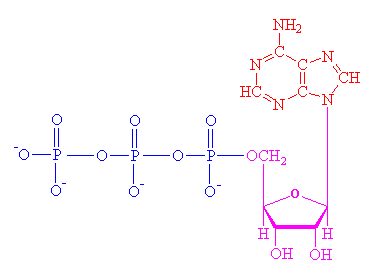
ATP
Even though the ATP molecule has been studied for
several decades the 1997 Nobel prize for Chemistry
has been awarded to 3 biochemists for the study of the important
biological molecule, adenosine triphosphate. ATP energeticsATP works by losing the end most phosphate group when instructed to do so by an enzyme. This reaction releases a lot of energy, which the organism can then use to build proteins, contact muscles, etc. The reaction product is adenosine diphosphate (ADP), and the phosphate group either ends up as orthophosphate (HPO4) or attached to another molecule (e.g. an alcohol). Even more energy can be extracted by removing a second phosphate group to produce adenosine monophosphate (AMP).
the energy is released HPO4 is produced (when bonds are broken) The reverse reaction takes place
and the phosphate group is reattached to the molecule using energy
obtained from food or sunlight. |